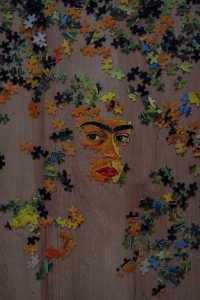Jigsaw puzzles have been a beloved pastime for centuries. They provide a fun, engaging challenge and come in countless designs to suit a wide range of interests. An integral aspect of putting a puzzle together involves “sorting” – organizing the jigsaw pieces either by shape or color. Analyzing the pros and cons of these two primary sorting strategies can vastly improve both your performance and enjoyment when diving into a new puzzle activity.
The Art of Sorting by Shape or Color
Sorting – the art of grouping like with like – is an integral part of puzzle-solving. It minimizes chaos, primes the brain for identifying patterns, and sets the stage for a smoother assembly process. The primary strategies employed by puzzle enthusiasts involve sorting by shape or color, both offering unique advantages and presenting their own challenges.
The Benefit of Shape: Precision and Pattern Recognition

Every puzzle piece is unique, even in a sea of hundreds or even thousands of pieces. The shape of each piece, with its unique combination of tabs (protrusions) and blanks (indents), holds clues to its position in the puzzle. Sorting pieces by shape involves keen observation and meticulous grouping of similarly shaped pieces.
This method plays to the strength of pattern recognition in the human brain. We naturally seek patterns in our surroundings as a survival instinct, and this is put to good use when sorting puzzle pieces by shape. Aligning pieces with similar shapes lays down an effective roadmap, enabling the puzzler to isolate edge segments, corner pieces, and any peculiarly shaped or uniquely identifiable pieces that could provide a swift point of connection. This precision-focused approach may especially appeal to puzzle aficionados who relish a careful, methodical strategy.
The Power of Color: Visual Clues and the Art of Puzzle Storytelling
On the other hand, sorting by color presents an approach that is less about the structure of the piece and more about the completed picture it will ultimately help create. Each color or color combination on a puzzle piece offers visual clues about where it might belong in the bigger picture.
The color-sorting method takes advantage of our brain’s excellent ability to track and recall color information. It is particularly effective when faced with puzzles that feature large areas of the same color or gradation. For instance, separating the sky from the earth in a landscape puzzle, or grouping together the pieces of a red dress in a classic portrait puzzle, becomes far more straightforward through color sorting.
Whether green trees, blue skies, or intricate color patterns on a ceremonial costume, these color clues allow one to visually story-tell the puzzle, piecing not just shapes but elements of the tale together.
The fundamental choice to be made then is whether the individual puzzle-solver finds more satisfaction in discerning the pattern of shapes or in revealing the story through color. Some might begin with a broad color sort, before fine-tuning their approach to a shape sort. Others might prefer to navigate their way around the puzzle through color alone. The pros and cons of both methods color the experience of creating the final puzzle image, adding an extra dimension of strategy to the tactile and cognitive joy of puzzle-solving.
When Pieces Fall Into Place: Pros & Cons of Sorting by Shape

Sorting by shape involves sifting through the sea of pieces and categorizing them based on their contours or how their edges are designed. This might mean singling out pieces that share the same outer edge shape, such as corners and edge pieces, or those with similar internal ‘knob and hole’ configurations.
The attraction to this method tends to be its specificity. Recognizing and grouping same shape pieces can provide a clear roadmap for where objects may fit. Unusual shapes, for example, can be quickly spotted and utilized. Children often practice sorting by shape in early learning activities, boosting their spatial skills.
However, sorting by shape is not without its drawbacks. Highly complex puzzles with numerous pieces of similar shapes can make this method less effective or downright overwhelming. It is also usually more time-consuming, as distinguishing between fine differences in shape to sort objects can require additional concentration and patience.
A Kaleidoscope of Colors: Pros & Cons of Sorting by Color

The alternate strategy – sorting by color – entails separating pieces based on their color patterns. Matching hues, gradient shades, or even pinpointing repeating color motifs or patterns can help early learners to quickly assemble large sections of the puzzle.
This method is particularly useful when your puzzle depicts a scene with distinct color zones – think large patches of green grass or a brilliant yellow sun. Ambiguous pieces with multiple colors can even be categorized into a ‘mixed’ batch, ready for further sorting later on.
However, it’s not all rainbows when we sort items by color. This method’s effectiveness may wane when puzzles incorporate intricate, overlapping color patterns or multiple shades of the same color. Deciphering slight color variances can be tricky, adding to the challenge.
Dovetailing Strategies: Combining Shape and Color
Puzzle enthusiasts often debate the supremacy of sorting by shape or color, but the smartest approach may combine these techniques. Depending on the complexity and design of your puzzle, you might alternate between shape and color strategies for different sections or stages of the puzzle assembly.
For example, beginners or children might start with color-sorting to quickly identify and group large color patches. A follow-up shape-sorting session can help match these color groups to their appropriate positions.
Above all, the preferred method largely depends on the individual’s abilities and preferences. Some individuals might find color and shape sorting equally effective, while others have a dominant method that works better for them.
Final Thoughts: The Fun of Fitting Pieces Together
The beauty of puzzles resides in their ability to cater to different individuals – from early learners to seasoned adults. Whether you’re a fan of sorting by shape or color, exploring the pros and cons of each method simply enriches your puzzle-solving experience.
Try to mix and match these strategies with your next puzzle and observe how each method impacts your performance and enjoyment – there’s no one-size-fits-all approach. As an added layer of fun, you can even turn your sorting regime into a scavenger hunt game with kids, encouraging them to identify and find pieces of specific colors and shapes within the pile.
And remember, while we’ve mostly spoken about the traditional, hand-held jigsaw puzzle pieces today, these sorting methods can also be applied to digital puzzles and even real-life problem-solving. So regardless of medium, keep on puzzling, and make the fitting of pieces more of a joy than a challenge.
So grab your deck of puzzles, sort through the array of shapes and colors, and begin your adventure in search of that satisfying moment when the pieces fit. Whether you’re in the classroom, at home, or via an online game platform, embrace the excitement of tracing the correct path to your puzzle’s beautiful image.
Each puzzle completed is a testament to patience, strategy, and the joy that comes in assembling various shapes and colors into a coherent, beautiful image. Happy puzzling!
Remember, good puzzle-solving is not a measure of intelligence but rather a skill developed through practice – so practice sorting puzzle pieces by color and shape on your next puzzle adventure!

